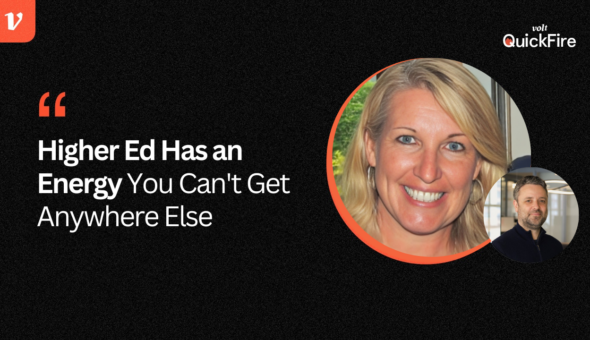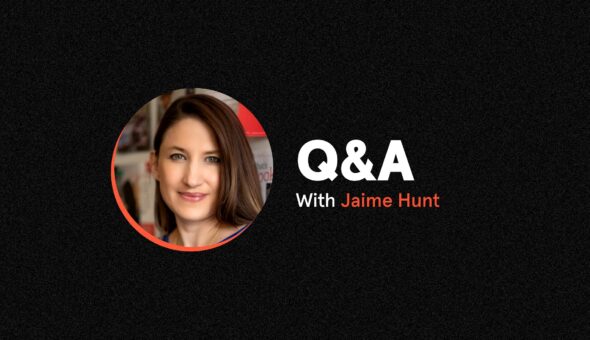In this exclusive virtual interview, Volt sat down with Dr. Cathy Sandeen, president of Cal State East Bay in Hayward, California. She shares her remarkable professional journey and insights into the challenges facing higher education. Join us for a captivating conversation that delves into the essence of effective leadership, the value of higher ed in fostering economic mobility and personal growth, and Dr. Sandeen’s vision for Cal State East Bay’s future.
Q&A with Cathy Sandeen: Courage, Conviction and Staying Focused on the ‘Why’
Dr. Cathy Sandeen, president of Cal State East Bay, discusses the essence of effective leadership and the value of higher education in fostering economic mobility.

Dr. Sandeen, could you describe your professional journey and how you became a president?
I started on the professor track, earning my Ph.D. in Communication and teaching for a while. Due to personal family circumstances, I had to move out of the classroom and into a full-time management or administration job. Though it seemed like a compromise initially, administration was an excellent fit for me. I missed the classroom and direct contact with students, but I found, through having a vision and priorities, building teams and deploying resources optimally, I could have a bigger impact on even more students.
I held leadership positions at University of California San Francisco, University of California Santa Cruz and UCLA. I was selected as an American Council on Education Fellow, 2010-11, a national leadership development program designed to build a diverse leadership pipeline for U.S. higher education.
I ultimately moved to Washington, D.C., to become vice president for Educational Attainment and Innovation at the American Council on Education, where I was exposed to higher education issues at a national level. That launched me into the university president/chancellor role. I was appointed as a chancellor within the University of Wisconsin System (2014–2018) and as chancellor of University of Alaska Anchorage (2018–2021) before returning home to the San Francisco Bay Area to become president of Cal State East Bay.
What was the single driving force behind your decision to join higher ed leadership?
I am a first-generation college graduate who grew up in working-class communities in the East Bay portion of the San Francisco Bay Area. Neither of my parents had the opportunity to complete college; in fact, my father dropped out of high school to join the military. My life would be completely different if I had not earned that first degree that set me on my path.
Public universities in California were even more affordable and accessible then than they are today. My career has been devoted to ensuring others, especially first-generation, low-income students of color, have the same opportunities I had. As the author and speaker Simon Sinek said, “Start with why.” Fostering access and degree completion is my “why.” I am grateful to be able to work in high-access public institutions.
What do you think are the greatest challenges facing higher ed leadership in general and Cal State East Bay specifically?
The negative public perception of the importance of a college degree, as well as the financial stability of colleges and universities, are the greatest challenges today.
Costs have increased because we want and need to pay our faculty and staff competitive salaries. We must meet an ever-increasing number of regulatory compliance requirements, making hiring additional highly paid administrators necessary. Keeping up with crucial baseline information technology systems and cyber security is expensive as well.
In the public high-access sector, we need to provide a substantial level of advising, mental health counseling, general support and belonging, as well as basic needs like financial assistance and food pantries. This requires additional resources beyond the cost of instruction. We also have high deferred maintenance backlogs needed to provide basic repairs to many of our facilities.
At the same time, there is political pressure to reduce state support and avoid tuition increases. Many colleges and universities have seen their enrollments decline due to demographics and adverse public perception. Here lies the challenge for so many of us.
What makes an effective leader in the current sociopolitical climate?
Courage, conviction and staying focused on the “why” of the job. Access to education remains essential for a civil, equitable and fair society.
In California, I am grateful we are able to emphasize the importance of equity, inclusion and anti-racism. For example, our legislature mandated an Ethnic Studies requirement as part of general education in the California State University System (of which our university is a part).
This is a departure from what is happening in other parts of the country. I firmly believe an effective leader today must keep equity, inclusion and anti-racism at the forefront through tangible actions and continuous systemic change and improvement.
You alluded to the ongoing debate in the public sector regarding the overall value of a college degree in the professional sphere. What would be your advice for those individuals without degrees that would persuade them to see the benefits of higher education?
To counter current negative perceptions about higher education, we can point out that the Georgetown University Center for Education and the Workforce has documented the economic and social value of a bachelor’s degree over decades.
Data indicates that on average, an individual with a bachelor’s degree will earn $1 million more over a lifetime than someone with a high school diploma. This same individual will tend to have better health outcomes, better retirement savings, higher education attainment for their children, greater civic participation and so forth. Despite the current rhetoric, the value of a degree has been well documented.
It is true that some employers, including state governments, have reduced or eliminated degree requirements for some positions. This does not mean a degree is not necessary or valuable for the majority of the workforce. We hear of high-profile technology companies in our region hiring software developers with no degree.
However, these employees likely come from privileged backgrounds, for example, parents who are professionals who can send them to high-performing high schools with computer science classes and who can buy them the latest in technology. This does not apply to the majority of our population who also deserve access to high-salaried employment.
A college degree gives you specific knowledge and skills, but it also imparts other important qualities such as communication, teamwork, organization, and time management, for example, as well as provides access to social networks, mentors, and internships necessary for entry into a profession. This access is essential for first-generation students who do not have access to professional networks through their families.
Would you appeal to the earning potential, or would you stress the importance of a wider knowledge base and personal growth?
Students who come to Cal State East Bay are primarily first-generation (63%), low-income (57% Pell Grant eligible) and students of color (86%). There is no doubt they come to us for economic mobility — to earn a family-sustaining salary to remain in the high-cost-of-living SF Bay Area.
Since the federal Morrill Act of 1890 established large, state-supported land-grant universities, the US has recognized the importance of technical knowledge in growing our economy. A focus on employment and income potential is not new.
Throughout our university — staff and faculty — we have no problem emphasizing future employment and economic mobility to our students and potential students. That said, over time, our graduates also recognize the broader knowledge, personal growth and value they received from their degrees. Ultimately, it’s a “both/and.”
What do you think is an institution’s primary objective in the lives of its students?
For Cal State East Bay, it is success in degree attainment, ensuring that every student who comes to us can achieve his/her/their goals. This means creating a sense of belonging so every student can find a place and ensuring students are exposed to diverse people and ideas.
How is Cal State East Bay navigating the ongoing challenge of the great resignation and the impending demographic cliff?
Fortunately, in our region, the “great resignation” has subsided. Fewer employees are departing and we are able to attract great new employees from robust and diverse applicant pools. Proudly stating our mission and attracting people who align with that mission has been key.
In terms of student recruitment, we have multiple strategies. We are becoming more adept at targeted digital and social media marketing because that’s where people go for information. We are reestablishing close ties with feeder high schools and community college counselors, post-Covid.
We are developing new academic programs in high-demand employment areas and are redesigning programs with the assistance of industry advisory boards. We also are developing more online and hybrid programs to attract working professionals with some college but no degree. We are examining and refining policies and practices that may create barriers to enrollment — many things.
What are your personal goals for Cal State East Bay as you move forward?
My personal goals are to ensure Cal State East Bay is well-known as an innovative and nurturing environment that emphasizes equity, inclusion and anti-racism, where anyone (student, staff and faculty, alike) can find an advocate, a sense of belonging and the drive to succeed.
I am very excited about a current brand refresh initiative that will help us define and emphasize what is distinctive and special about our university.
As we finish up our discussion, what do you believe is the key to leadership and what makes a great leader?
A great leader needs to be an authentic listener — a servant leader — who is not drawn to the position to be in the spotlight but who is there for the “why,” the mission and vision of the institution. In our case, it’s students.
A great leader needs to be able to build and nurture a high-functioning team that also aligns with the organization’s mission, individuals who can work independently but in synergy and with optimism, to advance organizational priorities.
A great leader needs to be able to articulate a vision for a brighter future, especially in times of challenge and adversity.
Newsletter Sign up!
Stay current in digital strategy, brand amplification, design thinking and more.
Also in Interviews

QuickFire: Kathy Kissane
16 questions with Thomas Jefferson University’s AVP of Marketing

QuickFire: Kin Sejpal
19 questions with the University of Redlands’ VP of Marketing and Communications

Q&A with Jaime Hunt: Strategy, Innovation and Initiative
Jaime Hunt, vice president and chief marketing officer, Old Dominion University discusses spam bots, college ROI and the role marketers should have in an institution’s leadership strategy.




